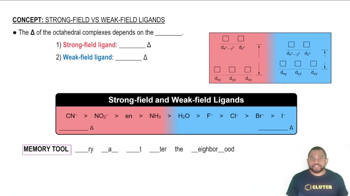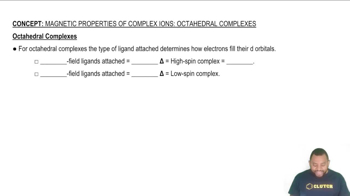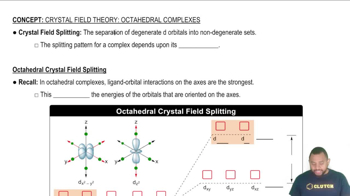Here are the essential concepts you must grasp in order to answer the question correctly.
Ligand Field Theory
Ligand Field Theory explains how the presence of ligands around a central metal ion affects the energy levels of the d-orbitals. In this theory, ligands can be classified as strong or weak field based on their ability to split the d-orbital energies. Strong field ligands cause a large splitting, leading to low spin complexes, while weak field ligands result in smaller splitting, often leading to high spin complexes.
Recommended video:
Strong-Field Ligands result in a large Δ and Weak-Field Ligands result in a small Δ.
Spin State of Complexes
The spin state of a complex refers to the arrangement of electrons in the d-orbitals, which can be either high spin or low spin. High spin complexes have unpaired electrons in higher energy orbitals due to smaller splitting, while low spin complexes have paired electrons in lower energy orbitals due to larger splitting. The spin state significantly influences the magnetic properties and reactivity of the complex.
Recommended video:
For octahedral complexes, Weak-Field Ligands create High-spin complexes and Strong-Field Ligands create Low-spin complexes.
Crystal Field Splitting Energy (Δ)
Crystal Field Splitting Energy (Δ) is the energy difference between the split d-orbitals in a transition metal complex. The magnitude of Δ is influenced by the nature of the ligands; weak field ligands produce a small Δ, favoring high spin configurations, while strong field ligands produce a large Δ, favoring low spin configurations. Understanding Δ is crucial for predicting the electronic structure and properties of coordination compounds.
Recommended video:
The crystal field splitting pattern for octahedral complexes has the d orbitals on or along the axes as having the higher energy.





